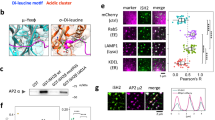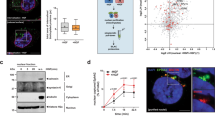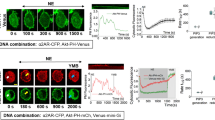Abstract
Recently, evidence has been accumulating that inositol and phosphatidylinositol polyphosphate play important roles in a variety of signal transduction systems including membrane traffic, actin cytoskeleton rearrangement and cell motility. In this paper, we show for the first time that the SH2-domain-containing inositol 5-phosphatase (SHIP)-2 binds directly to the hepatocyte growth factor (HGF/SF) receptor, c-Met, via phosphotyrosine 1356. HGF induces the breakdown of cell junctions and the dispersion of colonies of epithelial cells including MDCK cells. Whereas only few lamellipodia are observed in MDCK cells 2 min after stimulation with HGF, both SHIP-2- and SHIP-1-overexpressing cells form large, broad lamellipodia. The number of lamellipodia is 2–4-fold greater than that of mock-transfected MDCK cells in the same time period and SHIP is found to colocalize with actin at the leading edge. Furthermore, overexpression of a catalytic inactive mutant of SHIP-2 suppresses HGF-potentiated cell scattering and cell spreading, although these mutant-expressing cells form enhanced number of lamellipodia 2 min after HGF stimulation. Interestingly, cells expressing a mutant lacking the proline-rich domain of SHIP-2 at the C-terminal form few lamellipodia, but still spread and scatter upon stimulation with HGF at a reduced rate. These data suggest that phosphatase activity is required for HGF-mediated cell spreading and scattering but not for alteration of lamellipodium formation, while the proline-rich region influences lamellipodium formation. Furthermore, treatment with 10 μ M of phosphatidylinositol 3 (PI3) kinase inhibitor, LY294002, abrogates HGF-induced cell scattering of SHIP-2-overexpressing cells but not parental HEK293 cells, suggesting that a balance between PI3 kinase and SHIP is important for cell motility.
This is a preview of subscription content, access via your institution
Access options
Subscribe to this journal
Receive 50 print issues and online access
$259.00 per year
only $5.18 per issue
Buy this article
- Purchase on Springer Link
- Instant access to full article PDF
Prices may be subject to local taxes which are calculated during checkout









Similar content being viewed by others
References
Boccaccio C, Andò M, Tamagnone L, Bardelli A, Michieli P, Battistini C and Comoglio PM . (1998). Nature (London), 391, 285–288.
Bottaro DP, Rubin JS, Faletto DL, Chan AM, Kmiecik TE, Vande Woude GF and Aaronson SA . (1991). Science, 251, 802–804.
Bouscary D, Pene F, Claessens Y-E, Muller O, Chrétien S, Fontenay-Roupie M, Gisselbrecht S, Mayeux P and Lacombe C . (2003). Blood, 101, 3436–3443.
Dyson JM, Munday AD, Kong AM, Huysmans RD, Matzaris M, Layton MJ, Nandurkar HH, Berndt MC and Mitchell CA . (2003). Blood, 102, 940–948.
Dyson JM, O’Malley CJ, Becanovic J, Munday AD, Berndt MC, Coghill ID, Nandurkar HH, Ooms LM and Mitchell CA . (2001). J. Cell Biol., 155, 1065–1079.
Erneux C, Govaerts C, Communi D and Pesesse X . (1998). Biochem. Biophys. Acta, 1436, 185–199.
Giuriato S, Pesesse X, Bodin S, Sasaki T, Visla C, Marion E, Penninger J, Schurmans S, Erneux C and Payrastre B . (2003). Biochem. J., 376, 199–207.
Graziani A, Gramaglia D, Cantley LC and Comoglio PM . (1991). J. Biol. Chem., 266, 22087–22090.
Kawamura K, Takano K, Suetsugu S, Kurisu S, Yamazaki D, Miki H, Takenawa T and Endo T . (2004). J. Biol. Chem., 279, 54362–54371.
Khoury H, Dankort DL, Sadekova S, Naujokas MA, Muller WJ and Park M . (2001). Oncogene, 20, 788–799.
Khwaja A, Lehmann K, Marte BM and Downward J . (1998). J. Biol. Chem., 273, 18793–18801.
Koch A, Mancini A, Stefan M, Niedental R, Niemann H and Tamura T . (2000). FEBS Lett., 469, 72–76.
Liu Z-X, Yu FC, Nickel Ch, Thomas S and Cantley LG . (2002). J. Biol. Chem., 277, 10452–10458.
Ma AD, Metjian A, Bagrodia S, Taylor S and Abrams CS . (1998). Mol. Cell. Biol., 18, 4744–4751.
Mancini A, Koch A, Wilms R and Tamura T . (2002). Oncogene, 21, 1477–1484.
Mancini A, Niedenthal R, Joos H, Koch A, Trouliaris S, Niemann H and Tamura T . (1997). Oncogene, 15, 1565–1572.
Muraille E, Pessese X, Kuntz C and Erneux C . (1999). Biochem. J., 342, 697–705.
Naldini L, Weidner KM, Vigna E, Gaudino G, Bardelli A, Ponzetto C, Narsimhan RP, Hartmann G, Zarnegar R, Michalopoulos GK, Birchmaier W and Comoglio PM . (1991). EMBO J., 10, 2867–2878.
Pelicci G, Giordano S, Zhen Z, Salcini AE, Lanfrancone L, Bardelli A, Panayotou G, Waterfield MD, Ponzetto A and Pelicci PG . (1995). Oncogene, 10, 1631–1638.
Pesesse X, Deleu S, De Smedt F, Drayer L and Erneux C . (1997). Biochem. Biophys. Res. Commun., 239, 697–700.
Pesesse X, Dewaste V, De Smedt F, Laffargue M, Giuriato S, Moreau C, Payrastre B and Erneux C . (2001). J. Biol. Chem., 276, 28348–28355.
Ponzetto C, Bardelli A, Zhen Z, Maina F, dalla Zonca P, Giordano S, Graziani A, Panayotou G and Comoglio PM . (1994). Cell, 77, 261–271.
Prasad N, Topping RS and Decker SJ . (2001). Mol. Cell. Biol., 21, 1416–1428.
Prasad N, Topping RS and Decker SJ . (2002). J. Cell Sci., 115, 3807–3815.
Royal I and Park M . (1995). J. Biol. Chem., 270, 27780–27787.
Sakisaka T, Itoh T, Miura K and Takenawa T . (1997). Mol. Cell. Biol., 17, 3841–3849.
Stefan M, Koch A, Mancini A, Mohr A, Weidner KM, Niemann H and Tamura T . (2001). J. Biol. Chem., 276, 3017–3023.
Stoker M and Perryman M . (1985). J. Cell Sci., 77, 209–223.
Tamura T, Mancini A, Joos H, Koch A, Hakim C, Dumanski J, Weidner KM and Niemann H . (1999). Oncogene, 18, 6488–6495.
Taylor V, Wong M, Brandts C, Reilly L, Dean NM, Cowsert LM, Moodie S and Stokoe D . (2000). Mol. Cell. Biol., 20, 6860–6871.
Tsujishita Y, Gua S, Stolz LE, York JD and Hurley JH . (2001). Cell, 105, 379–389.
Vollenweider P, Clodi M, Martin SS, Imamura T, Kavanaugh WM and Olefsky JM . (1999). Mol. Cell. Biol., 19, 1081–1091.
Wang Y, Keogh RJ, Hunter MG, Mitchell CA, Frey RS, Javaid K, Malik AB, Schurmans S, Tridandapani S and Marsh CB . (2004). J. Immunol., 173, 6820–6830.
Weidner KM, Di Cesare S, Sachs M, Brinkmann V, Behrens J and Birchmeier W . (1996). Nature (London), 384, 173–176.
Weidner KM, Sachs M, Riethmacher D and Birchmeier W . (1995). Proc. Natl. Acad. Sci. USA, 92, 2597–2601.
Wisniewski D, Strife A, Swendeman S, Erdjument-Bromage H, Geromanos S, Kavanaugh WM, Tempst P and Clarkson B . (1999). Blood, 93, 2707–2720.
Acknowledgements
We thank Karsten Heidrich, Regina Wilms and Sabine Klebba-Färber for technical assistance, Christophe Erneux (Université Libre de Bruxelles, Brussels) for providing the SHIP-2 and its mutant cDNAs, Larry Rohrschneider (Fred Hutchinson Cancer center, Seattle) for providing the SHIP-1 cDNA, Walter Birchmeier for providing the Met and its mutants cDNA and C Bruce Boschek for critically reading the paper. This research was supported by the Deutsche Forschungsgemeinschaft (Ta-111/8/-3) and Sonderforschungsbereich 566 (B2).
Author information
Authors and Affiliations
Corresponding author
Rights and permissions
About this article
Cite this article
Koch, A., Mancini, A., El Bounkari, O. et al. The SH2-domian-containing inositol 5-phosphatase (SHIP)-2 binds to c-Met directly via tyrosine residue 1356 and involves hepatocyte growth factor (HGF)-induced lamellipodium formation, cell scattering and cell spreading. Oncogene 24, 3436–3447 (2005). https://doi.org/10.1038/sj.onc.1208558
Received:
Revised:
Accepted:
Published:
Issue Date:
DOI: https://doi.org/10.1038/sj.onc.1208558
Keywords
This article is cited by
-
An auxiliary binding interface of SHIP2-SH2 for Y292-phosphorylated FcγRIIB reveals diverse recognition mechanisms for tyrosine-phosphorylated receptors involved in different cell signaling pathways
Analytical and Bioanalytical Chemistry (2022)
-
Met-Controlled Allosteric Module of Neural Generation as A New Therapeutic Target in Rodent Brain Ischemia
Chinese Journal of Integrative Medicine (2021)
-
Suppression of SHIP2 contributes to tumorigenesis and proliferation of gastric cancer cells via activation of Akt
Journal of Gastroenterology (2016)
-
Inhibition of Abl tyrosine kinase enhances nerve growth factor-mediated signaling in Bcr–Abl transformed cells via the alteration of signaling complex and the receptor turnover
Oncogene (2008)
-
FMIP controls the adipocyte lineage commitment of C2C12 cells by downmodulation of C/EBPalpha
Oncogene (2007)



